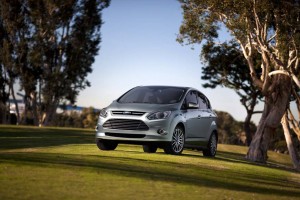
Ford will offer the C-Max with only a choice of two hybrid drivelines, including the extended-range C-Max Energi plug-in.
This story has been updated from the original to include more detail and official Ford comments on the C-Max project. TheDetroitBureau.com Editor Joe Szczesny contributed to this report.
Ford Motor Co. planners have shifted direction for the upcoming launch of the all-new C-Max microvan. The new people mover will be sold only as a hybrid model, becoming the first dedicated gas-electric offering in the Ford line-up.
While Ford has decided to scrub a gas-powered, three-row version of the C-Max, the 2-row 5-seater will give U.S. buyers a choice of two battery-based drivetrains: a conventional hybrid, similar to the system now used in models such as the Ford Escape Hybrid, and a new plug-in version, the first time Ford has used that technology, which will allow a motorist to run extended distances on battery power alone.
“This is our Prius fighter,” said Jim Farley, Ford vice president of global marketing, sales and service, said Thursday as he showed off the hybrid version of the C-Max multi-purpose vehicle during a press conference at a Ford transmission plant outside Detroit.
There are several reasons for the change in strategy. For one thing, Farley had argued that the maker needs a true high-tech halo car, much like the Toyota Prius, that is offered solely with hybrid technology. Though Ford has greatly expanded its gas-electric line-up – and plans to have five battery-electric or plug-in models on the market before mid-decade – it doesn’t have a visually distinctive model that effectively says “hybrid.”
“We did a lot of research,” said the marketing czar, that suggested having a distinctive shape that is easily recognizable not only helps Toyota sell more Prius hybrids but gives an image benefit to the rest of its line-up.
Meanwhile, the focus on going hybrid-only will “simplify” the choice for consumers, especially at a time when American motorists are trying to cope with fuel prices that are approaching the previous record of $4.09 a gallon set in July 2008.
“People are very conscious of fuel efficiency. They want new solutions,” said Farley. Ford has pinned much of its future success on greening its line-up. While it isn’t walking away from big trucks such as the F-Series, long America’s best-selling product line, it is greatly expanding its passenger car offerings with models like the Fiesta minicar. CEO Alan Mulally earlier this week predicted that by decade’s end small cars will account for 55% of the maker’s total global sales — which Ford hopes to boost from 5.2 million to more than 8 million by around 2015. (For more on that story, Click Here.)
The decision to go hybrid only with C-Max is not without some controversy and risk. Hybrid sales actually fell last month, as TheDetroitBureau.com previously reported. (Click Here for that story.) The shortage of Japanese-made vehicles was one factor, but buyers also appear reluctant to pay the premium for battery-based vehicles, which can be difficult to recover even through significant savings on fuel.
Ford is not expected to release pricing on the new C-Max Hybrid and C-Max Energi – the name given the plug-in version – until closer to their 2012 launches. The latter model will adopt a larger lithium-ion battery pack that is expected to yield as much as 20 miles or more in electric mode, though Ford has not yet released final specifications.
(Click Here for a closer look at the C-Max Energi.)
The C-Max is an American version of what is known in Europe as the Grand C-Max, a downsized minivan that shares its underlying platform and many key components with the new 2012 Ford Focus. That model will be offered with a pure battery-electric drivetrain option starting next year, as well.
With the addition of the various new battery-based offerings, Ford expects to boost North American sales of its various electrified vehicles to 100,000 by 2013, up from 35,000 for its various hybrids last year.
While the modified C-Max plans call for the use of only battery-based propulsion, a Ford source acknowledged the maker has not completely ruled out the option of adding a more conventional gasoline drivetrain at a later date if it saw the potential demand.
The launch of the new people mover is expected to result in the addition of 220 jobs. The maker has also added 50 additional engineers to its electric propulsion team over the last year. Additional jobs will be created when Ford brings production of its next-generation hybrid drivetrain in-house. The technology is currently being produced for it by supplier Aisin.
